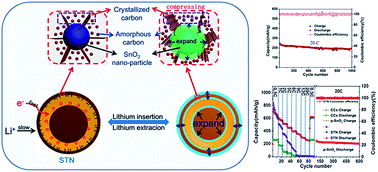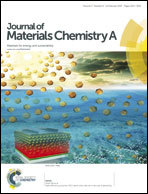Design of SnO2/C hybrid triple-layer nanospheres as Li-ion battery anodes with high stability and rate capability†
Abstract
The problems of the large volume change during Li insertion and extraction and poor high-power performance of SnO2-based electrodes should be solved for their practical application. Herein, a novel SnO2/C hybrid triple-type nanosphere, in which a layer of amorphous carbon was sandwiched between the layers of the SnO2 and carbon composite, has been designed and fabricated by a top-down approach. Due to its special structure, this kind of SnO2-based electrode exhibited a considerable capacitive performance, offering a greatly enhanced cycling stability and rate capability. Its capacity remained as high as 653 mA h g−1 after the 350th cycle. The irreversible capacity decay was unprecedentedly extended to the 80th cycle. What is more, this electrode even exhibited a capacity of 260 mA h g−1 at 20 C, with a fading of less than 16% after 600 cycles and less than 22% even after 1000 cycles.


 Please wait while we load your content...
Please wait while we load your content...